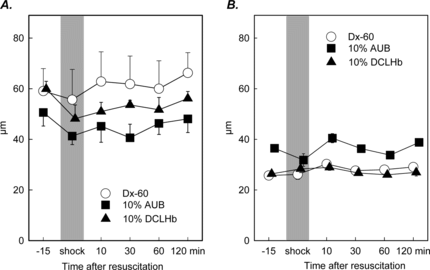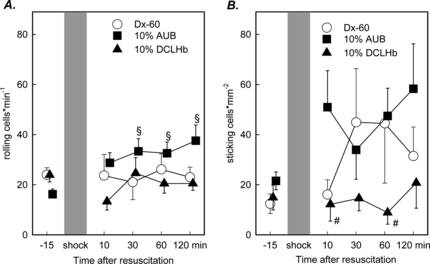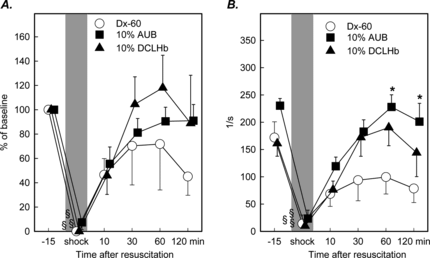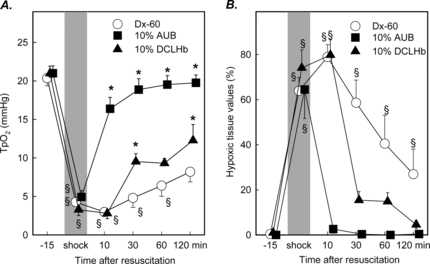Figures & data
Table 1 Heart rate (HR) and mean arterial pressure (MAP) before, shock, during shock and after resuscitation (mean ± SD, n = 6–8 animals per treatment group; *p < 0.05 vs. NaCl 0.9% and Dx-60, Mann-Whitney U-Test)
Figure 1 Diameter of arterioles (A) and postcapillary venules (B) in striated skin muscle after hemorrhagic shock and resuscitation (mean ± SEM, n = 6–8 per experimental). No significant changes were observed over the entire observation period.

Figure 2 Rolling leukocytes (A) and sticking leukocytes (B) in postcapillary venules after resuscitation from hemorrhagic shock (mean ± SEM, n = 6–8 animals per exp. group; § p < 0.05 vs. Baseline, Wilcoxon test; # p < 0.05 10 g% AUB vs. 10 g% DCLHb, Mann Whitney U-Test).

Figure 3 Macromolecular leakage (A) and functional capillary density (B) in the striated skin muscle following hemorrhagic shock and resuscitation. Animals were treated either with Dx-60, 10 g% AUB or 10 g% DCLHb (mean ± SEM, n = 6–8 per exp. group; *p < 0.05 vs. Dx-60 Mann Whitney U-test; § p < 0.05 vs. baseline Wilcoxon test).

Figure 4 Red blood cell velocity in percentage of baseline values (A) and shear rates (B) in postcapillary venules of animals resuscitated either with Dx-60, 10 g% AUB or 10 g% DCLHb (mean ± SEM, n = 6–8 per exp. group; *p < 0.05 vs. Dx-60 Mann Whitney U-test; § p < 0.05 vs. baseline Wilcoxon test).

Figure 5 Local tissue oxygenation (A) and frequency of tissue hypoxia (B) with values ranging from 0–5 mmHg in striated muscle prior to shock and following resuscitation with Dextran, 10 g% AUB or DCLHb (mean ± SEM, n = 6 per exp. group; *p < 0.05 vs. Dx-60 Mann Whitney U-test; § p < 0.05 vs. baseline Wilcoxon test).
